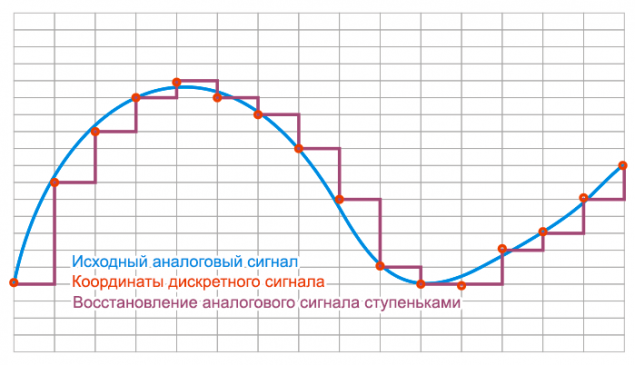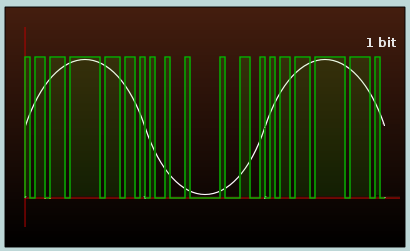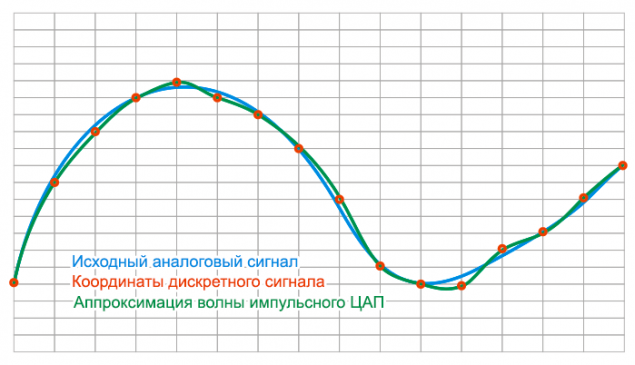Differences between the analog sound from digital
 Bashny.Net
Bashny.Net

Very often we hear terms such as "digital" and "digital" signal, how is it different from the "analog"?
The essence of the differences is that the analog signal is continuous in time (blue line), while the digital signal is composed from a limited set of coordinates (red dots). If you reduce everything to the coordinates, any segment of the analog signal consists of an infinite number of coordinates.
Y coordinates of the digital signal on the horizontal axis are arranged at regular intervals in accordance with the sampling frequency. The common format Audio-CD is 44,100 points per second. Vertical accuracy of the position corresponds to the height of the bit digital signal to 8 bits is 256 levels for 16 bits = 65,536 for 24 bits = 16777216 levels. The higher the bit depth (number of levels), the closer to the vertical coordinates of the initial wave. I>
Analog sources are vinyl and cassettes. Digital sources are: CD-Audio, DVD-Audio, SA-CD (DSD), and WAVE files to and DSD formats (including derivatives APE, Flac, Mp3, Ogg, etc.).
Advantages and disadvantages of the analog signal
The advantage of the analog signal is that it is in analog form we perceive sound with our ears. And although our auditory system translates the perceived audio stream to digital form and passes in this form in the brain, science and technology has not yet reached the possibilities in this form to connect players and other sound sources straight. Similar studies are now actively underway for people with disabilities, and we enjoy extremely analog sound.
The disadvantage of the analog signal is possible for the storage, transmission and replication signal. When recording on a tape or vinyl, the quality of the signal will depend on the properties of the tape or vinyl. Over time, the tape is demagnetized and the quality of the recorded signal deteriorates. Each reading gradually destroys the medium, and dubbing introduces additional distortion, which adds additional deflection next media (tape or vinyl), a reader, recording and transmission.
Make a copy of an analog signal, it would be like to copy photos to photograph it again.
Advantages and disadvantages of digital signal
The advantages of digital signal relates accuracy when copying and transmitting the audio stream, where the original is no different from the copy.
The main disadvantage is that the signal in digital form is an intermediate stage and the final accuracy of the analog signal will depend on how detailed and accurate coordinates will be described in the sound wave. It is logical that the more dots and the more accurate coordinates will be, the more accurate will be a wave. But so far there is no consensus, a number of coordinates and the accuracy of the data is sufficient for that to say that a digital representation of the signal is sufficient to accurately reconstruct an analog signal that is indistinguishable from the original by our ears.
If the handle volumes of data, the capacity of a conventional analog cassette 700-1 is only about 1 MB, while a normal CD holds 700 MB. This gives an idea of the necessity of large-capacity vehicles. And it creates a separate war compromises with different requirements on the number of points and describing the accuracy of coordinates.
Today it is considered quite sufficient representation of a sound wave with a sampling rate of 44, 1 kHz and 16 bit. When the sampling frequency 44 kHz, one can reconstruct the signal with a frequency of 22 kHz. As the psycho-acoustic research, a further increase in the sampling rate barely noticeable, but increasing the discharge gives a subjective improvement.
How to build a DAC wave
DAC - a digital-to-analog converter, an element that carries digital audio to analog. We will look at the basic principles of surface. If your comment will be visible interest in more detail the number of points will be issued a separate article.
Multibit DAC
Very often the waves are in the form of steps, due to the architecture of the first generation of multibit DAC R-2R, operating similarly to a switch of the relay.

The input of the DAC to the value of another position in the vertical and in each of its cycle it switches the current level (voltage) to the appropriate level until the next change.
Although it is believed that the human ear hears no more than 20 kHz, and the Nyquist theory can restore signal to 22 kHz, the question remains the quality of the signal after recovery. At high frequencies resulting form the "step" waves are usually far from the original. The easiest way out - is to increase the sampling rate of the recording, but it leads to a substantial and undesirable increase in file size.

The alternative - to artificially increase the sample rate when playing in the DAC, adding the intermediate values. Ie we present a path of continuous wave (gray dashed line), smoothly connecting the original coordinates (red dots) and add intermediate points on the line (dark purple).
By increasing the sampling rate is usually necessary to increase and capacity to coordinate are closer to approximate wave.

Due to the intermediate coordinates it is possible to reduce "step" and to build closer to the original wave.
When you see the function of increasing the frequency from 44.1 to 192 kHz in the player or an external DAC, it is a function of adding the intermediate coordinate rather than restoration or creation of sound in the region above 20 kHz.
Initially, it was up to individual SRC chip DACs, which then moved directly to the DAC chips themselves. Today, you can find solutions, which is added to the current DAC this chip, this is done in order to provide an alternative to built-in algorithms to DAC and often get even better sound (such as is done in the Hidizs AP100 ).
The main failure of the industry from the multibit DAC was due to the impossibility of further technological development of quality indicators at current production technology and higher value against the "impulse" DACs with comparable characteristics. However, in the Hi-End products, preference is given often old multibit DAC am, rather than new solutions with technically good performance.
Pulse DAC
In the late 70-ies became widespread alternative embodiment DACs based on the "pulse" of architecture - "delta-sigma". Technology pulse DACs is made possible appearance super-fast keys and allowed to use a high carrier frequency.

The amplitude of the signal is the average of the amplitudes of pulses (shown in green pulses of equal amplitude and white final sound wave).
For example, eight slots in sequence five pulses will averaged amplitude (1 + 1 + 1 + 0 + 1 + 0 + 1 + 0) / 8 = 0 and 625. The higher the carrier frequency the greater the pulse falls under the smoothing and obtain a more accurate value amplitude. It is allowed to present the audio stream in the form of one-bit dynamic range.
Averaging may do conventional analog filter, and if such a set pulse is applied directly to the speaker, the output we get the sound and ultra-high frequencies will not be played due to the large inertia of the radiator. According to this principle works PWM amplifiers in class D, where the energy density of the pulse is created not by their number and the duration of each pulse (which is easier to implement, but can not be described by a simple binary code).
Multibit DAC can be represented as a printer capable of a color pantonovymi colors. Delta-Sigma - is an inkjet printer with a limited set of colors, but with the possibility of applying a very small points (compared with antlers printer), by varying the density of pixels per unit area gives you more shades.

In the image, we generally do not see the individual pixels of the low resolution of the eye, and only the middle tone. Similarly, the ear does not hear the pulse individually.

In the end, when the current technology in the pulsed wave DAC can get close to that which in theory should get in the approximation of the intermediate coordinate.
It should be noted that after the appearance of delta-sigma DAC urgency faded paint "digital wave" steps since so steps wave modern DACs do not build. Correct digital signal connection points to build a smooth line.
Is the ideal pulse DAC? B>
However, in practice not all rosy, and there are a number of problems and constraints.
Because the vast number of records stored in the multi-bit signal, then transfer to a pulse signal on a "bit by bit" requires unnecessarily high carrier frequency, which do not support the current DAC.
The main function of the pulse of modern multi-bit DAC is a translation of a one-bit signal with a relatively low carrier frequency decimation data. Basically, these algorithms and determine the final quality of the sound pulse DACs.
To reduce the problem of high carrier frequency, the audio stream is divided into multiple single-bit streams where each stream is responsible for a group of digits, which is equivalent to a multiple of the carrier frequency by increasing the number of streams. These DACs are called multibit delta-sigma.
Today, pulse DAC's got a second wind in the high-speed general-purpose chips in products of NAD and Chord by enabling flexible program transformation algorithms.
Format DSD
After widespread delta-sigma DACs logical appearance was recording format binary code directly sigma-delta encoding. This format called DSD (Direct Stream Digital).
A widespread format is not received for several reasons. Edit files in this format proved too limited: you can not mix the streams, adjust the volume and apply equalization. This means that without any loss of quality can only back up the analog recording and producing dvuhmikrofonnoy record live performances without further processing. In short - not really earn money.
In the fight against piracy drives SA-CD format is not supported (not supported until now) computers that does not allow copies. No copies - no wider audience. Play DSD audio content can be only a single SA-CD player with a firm drive. If there is a standard PCM format SPDIF digital data from a source to a separate DAC, for the DSD format standard no first pirated copies of SA-CD discs were digitizing analog output SA-CD player (though the situation seems silly, but actually some records out only SA-CD, or the same account on Audio-CD was specially made for the promotion of poorly SA-CD).
The turning point came with the release of game consoles SONY, where the SA-CD disc to play automatically copied to the hard drive console. We took advantage of fans size DSD. The emergence of pirate records stimulated the market to issue separate DAC for playback DSD stream. Most external DAC supporting DSD today supports USB data format DoP using a separate digital signal encoding through SPDIF.
The carrier frequencies for DSD relatively small, 2.8 and 5.6 MHz, but the audio stream does not require any changes to the decimation of data and is quite capable of competitive high-definition formats such as DVD-Audio.
On the question of which is better, DSP and PCM no single answer. Everything rests on the quality of the implementation of the specific DAC and talent sound engineer while recording destination file.
The overall conclusion
Analog sound - that's what we hear and perceive the world through the eyes of both. Digital sound, a set of coordinates describing the sound wave and that we can not hear directly without conversion to an analog signal.
The analog signal is recorded directly on a cassette tape or vinyl impossible to overwrite without loss of quality, while the wave in the digital representation may be copied bit by bit.
Digital recording formats are a constant trade-off between the amount of precision coordinate against the file size of any digital signal and is only an approximation to the original analog signal. However, the different levels of technology, recording and playback of digital signal and storage media for analog signal give more advantages of digital signal representation, similar to a digital camera versus a film camera. My sound sources Computer CD-player Portable Digital Player td > Vinyl Other Smartphone Voted 226 people. 22 people abstained. Only registered users can vote in polls. Sign , please.
Source: geektimes.ru/company/soundpal/blog/249814/
Tags
See also
What a man you deserve or what it feels like to be a woman?
Time management for busy parents
Archpriest Alexei Uminsky on the subtraction of prayers and formal confession
Portable audio: Myths and Reality
Cult of razer: headset Kraken
Why all the modern record sound the same?
The first Soviet ABM
History of guitar
You and your work *
















